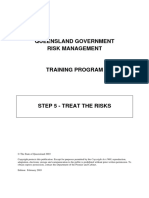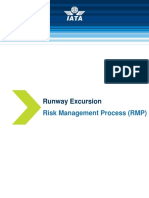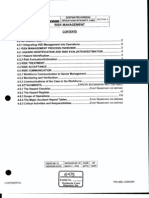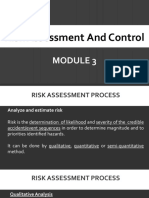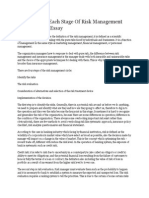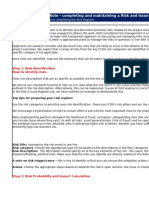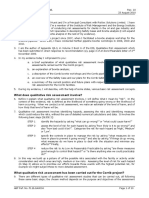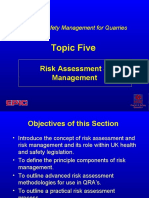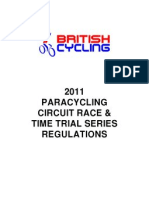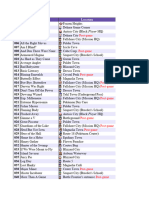Risk Assessment Issue 1
Risk Assessment Issue 1
Uploaded by
api-90772375Copyright:
Available Formats
Risk Assessment Issue 1
Risk Assessment Issue 1
Uploaded by
api-90772375Original Title
Copyright
Available Formats
Share this document
Did you find this document useful?
Is this content inappropriate?
Copyright:
Available Formats
Risk Assessment Issue 1
Risk Assessment Issue 1
Uploaded by
api-90772375Copyright:
Available Formats
Hand Cycling Association UK
Procedure for the Assessment of Risks on Routes
Scope
This procedure is designed to specify the associations requirements for the appointment and specifies the duties and responsibilities of a Route Risk Assessor (RRA). A competent RRA is either appointed by, or can be the Ride Leader (RL).
Introduction
The Risk Assessment (RA) is designed to support the RL with a tool for estimating and controlling risks. The RL will use their discretion to decide if a written risk assessment is necessary and if so, they will also decide on the level of detail required in its completion. This decision should be documented and retained. The risk assessment forms a part of the evidence to support the HCAUK responsibility when sanctioning or organising an event and if one is required, it should also be retained.
Required attributes of a RRA
A RRA is required to be:1. a very experienced cyclist/handcyclist, familiar with handcycling 2. to have a good knowledge of the Highway Code 3. to have successfully completed the HCAUK RRA course It is the RRA responsibility to complete the RA process competently.
The process
The level of the experience of the expected group members drives the level of detail required when completing the risk assessment. If the ride is aimed at or will include novice level riders then it requires maximum detail which will normally require a route inspection prior to the ride. If however, it is intended for experienced handcyclists, a close inspection of the route with a suitable map might be sufficient. When considering the risks of a route, the experience of the least experienced handcyclist must always be considered, always erring on the side of caution as regards the participants.
Page 1 16/01/2012 issue 1
HCAUK, Procedure for the Assessment of Risks on Routes
The risk assessment includes the following steps; 1) Hazard identification. 2) Assign the Likelihood mark. 3) Assign the Outcome mark. 4) Calculating or assign the Risk marks. 5) Identifying any Mitigation and assigning a mark. 6) Calculating the Residual Risk. The aim of the risk assessment is to identify the risks and where possible reduce the risk with mitigation to an acceptable level. The process is a guide and so the order of completing, the values of the mark assigned are at the discretion of the assessor.
Definition and examples of terms
Marking values are suggested in this process for completing the RA and are given in brackets, ().
Hazards
A hazard presents an increase in risk over the risks encountered over the majority of the route. Crossing a busy main road presents an increased risk as compared to that of riding on lightly used country. Hazards are either Fixed identifiable parts of a route such as a blind corner, a pothole, or busy road junction, or General, such as the weather of the day, or the experience of the hand-cyclists, etc. A General hazard is a risk that can aggravate a fixed hazard. Hazards at the start or finish of a route should also be included. It is far better to over identify hazards, which can then be assigned the appropriate marks, which may then suggest that some hazards are insignificant, than to miss any hazards which later transpire to be significant.
Page 2 16/01/2012 issue 1
HCAUK, Procedure for the Assessment of Risks on Routes
Likelihood Likelihood is the chance of an incident occurring at a hazard. This can be affected by the weather, time of day, length of time exposed to a hazard and marked accordingly. An incident is far more likely to occur at say a bend at the bottom of a long steep hill, if raining or at night; 1) Remote, very unlikely to cause an incident, (0). 2) Low, if one hundred hand-cyclists, of varying experience, passed this hazard you would not expect an incident, (1). 3) Medium, you would expect one, of one hundred hand-cyclists, of varying experience, to have an incident at this hazard, (2). 4) High, you would expect at least one in ten, hand-cyclists of varying experience, or worse to have an incident at this hazard, (3). The likelihood is also affected by the General risks such as the experience of the hand-cyclists etc. Note, in this process General risk are not assigned a likelihood value. Outcome If an incident did occur at a hazard, what would be the probable outcome? The outcome is likely to depend on the exact circumstances of the hazard. Using the example above, if the bend is a right hand bend, on a lightly used country road, with soft grassy verge on the left hand side for the hand-cyclist to run into, then the Outcome is likely to be low, (0) or (1) even if at night in the rain. If the bend is a left hand bend, on a major road, then the outcome could be far more serious, (2) or (3). 1) None, some inconvenience but no injury, i.e. recoveries easily from exhaustion (0). 2) Slight, minor injury, sprain or graze, prolonged exhaustion (1). 3) Serious, injury requiring Hospital out patients treatment, (2). 4) Severe, injury requiring Hospital in patient treatment or loss of life (3). To highlight the reason for using probable rather than worst case outcome consider these examples; 1. The probable outcome if hit by a car on a fast main road is far more likely to be severe. 2. The probable outcome if hit by a car travelling on a narrow county road might only is between slight or serious. The underlying assumptions is that in the first example the car is far more lightly to be travelling at high speed and the driver is not expecting sudden unusual events, where as in the second case the car is travelling slower, the driver is expecting unusual events. Of course in both cases the worst case outcome could be death, but this has a very low probability whereas the probable outcome is the most lightly. The outcome is also affected by the General risks such as the weather, experience of the hand-cyclists etc. Note, in this process General risk are not assigned an outcome value. Page 3 16/01/2012 issue 1
HCAUK, Procedure for the Assessment of Risks on Routes
Risk Risk values are directly assigned for General risks, whereas fixed hazards are assigned a risk value with the summation of the Likelihood and Outcome marks. If the risk value is; 1) 1, consider mitigation with at least a weak control measure, 2) between 2 &3 mitigate with a mid control measure, 3) is 4 mitigate with a strong control measure, 4) 5 or greater, then mitigate with a very strong control measure. Mitigation Mitigation is a control measure used to reduce the risk. Identify the most appropriate control measure(s), assign a value. A single hazard can be assigned any number of control measures. 1) Weak control; an example could be the posting of warning signs to warn other road users of a Hand-Cycling event. This is a weak control because it relies on other road users to take the control action, (1). 2) Mid control; an example could be warning each group member of the hazard, this requires each group member to note and respond correctly, (2). 3) Strong control: could be to warn each group member of the hazard and place a ride marshal at the hazard location to further warn the group members and to warn other road users. A second example could be to assign an experienced rider as a buddy to any novice rider. A buddy can be thought as a marshal travelling with the novice, (3). 4) Very Strong control; could be the re-routing of the event to avoid the hazard or to cancel the event, (4). Residual Risk Residual risk is the remaining risk, after all mitigations have been applied. This provides RL with the guidance as to whether or how to continue the proposed ride. If any residual risk value is greater than 2, the RL should carefully consider the risk, the experience of participants, and only continue if he modifies and signs the entry, to reduce the value on the RA. If the residual value is 2, this is a risky ride and can only continue at the discretion of the RL.
Page 4 16/01/2012 issue 1
HCAUK, Procedure for the Assessment of Risks on Routes
How to complete the Risk Assessment All the items below are inserted to their respective column on the RA form. Step 1 Identify and add any a description of any General hazards to the first column labelled Hazards, as suggested below in section Typical General Hazards, and insert a mark value in the Risk column. Step 2 Identify and describe any other hazards, also to the first column together with any location information in the second column labelled Location. Step 3 Other than General hazards, estimate the Likelihood of an incident occurring at each hazard, and add your mark to the column labelled Likelihood. Step 4 Other than General hazards, the Outcome is the estimate of the probable severity of the injury arising from an incident. Add the mark to the Outcome column. Note; the probable outcome is not the worst case outcome. Step 5 Calculate and enter the Risk value in the column labelled Risk. Step 6 Mitigate with any control measures, and add a short description of the control measure to the Mitigation column and add the mark in the next column labelled Mark. Step 7 Calculate the residual risk by subtracting the mitigation value from the risk value and enter the result in the column labelled residual. Note, if a residual risk value is calculated as to be less than zero, insert a value of zero. Typical General Hazards, marking values are inserted into the Risk column. Hand cyclists experience. Typically you would expect riders to fall within these categories, where the descriptions are only indicators and not a rigorous measure. For example, you would not demote a very experienced rider to an experienced rider because they fail to carry one or some of these items; 1. Very experienced, often rides extended routes in excess of 50 miles in varying conditions, has been riding for at least two years, would have contingency items such as additional clothing, energy bars/gels, and
Page 5 16/01/2012 issue 1
HCAUK, Procedure for the Assessment of Risks on Routes
repair items and tools to cope with a tyre, chain or control cable failure and more than adequate hydration, (0). Experienced, often rides routes that less than 50 miles but greater than 20 miles in varying conditions, has been riding for at least one year. An experienced rider might have some contingency items such as additional clothing, energy bars/gels, and repair items and tools to cope with a tyre, chain or control cable failure and adequate hydration, (1). General rider, often rides routes that less than 50 miles but greater than 20 miles in benign conditions, has been riding for less than one year. A general rider might have some contingency items such as additional clothing, energy bars/gels, and repair items to cope with a puncture and adequate hydration, (2). Novice rider, new rider that occasionally rides less than 20 miles in benign conditions, is unlikely to have any contingency items and may not have any hydration, (3).
2.
3.
4.
Mitigation could be if an experienced buddy is assigned to help and advise the less experienced rider. This is a strong control measure with a mitigation value of, (3). Weather 1. Mild clear day with low wind and a good weather forecast, the temperature is between 15C and 25C, (0). 2. Mild wet day with low winds expected to be encountered during the ride, and the temperature is between 15C and 25C, (1). 3. If the temperature is high it is less than 32C or if the temperature is low it is between 15C and 5C or heavy rain is likely, mist, windy, expected to be encountered during the ride (2). 4. Very high temperature that is greater than 32C or if the temperature is low it is between 5C but 0C, fog, heavy rain with a chance of some flooding, or gale force winds expected to be encountered during the ride (3). 5. Very low temperature below 0C, snow, ice, heavy fog, very heavy rain and flooding will be encountered, storm force winds expected to be encountered during the ride (4). The mitigation of weather is the combination of the experience and clothing of the group members. For example if all the group members are correctly dressed or have access to the correct clothing for the conditions; 1. Very experienced hand cyclists, (3). 2. Experienced hand-cyclist, (2). 3. General rider, (1). 4. Novice rider, (0). If the group members are incorrectly clothed and dont have access to the correct clothing; then the mitigation marks should be reduced to; Page 6 16/01/2012 issue 1
HCAUK, Procedure for the Assessment of Risks on Routes
1. 2. 3. 4. Very experienced hand cyclists, (2). Experienced hand-cyclist, (1). General rider, (0). Novice rider, (0).
Examples; 1. Very low temperatures with a mark value of 4, where the outcome could be hypothermia or frostbite. The likelihood of this outcome depends on the riders clothing and experience. An experience rider will be physically fit, more able to maintain body heat in adverse conditions and so should have a mitigation value of 2. The Residual Risk value would be 2 and only continued at the discretion of the RL. 2. A second example could be the hazard of a windy day, where fatigue or exhaustion is the Risk if the route contains long sections of riding into wind with a Risk mark value ranging from say 2. If the group of riders are very experienced then the mitigation mark value would be 3, resulting in a residual risk mark of 0, (if result is less than zero then insert zero). Examples Below are two examples, the first is a training ride from Stoke Mandeville organised by Matt Lindley and the second is the Cumberland Challenge sportive ride. On the first all the residual risks are zero or one, whereas the risks before control measures were between one and three. The control measures are not difficult to implement, the most difficult being the placing of signs to warn other road users of the presence of handcycles around the training loop. This could easily be completed prior to the ride, while checking for any additional hazards that need to be entered into the RA. This would be a good opportunity to place temporary direction signs to aid those who are taking part in the ride. The second risk assessment is for the Cumberland Challenge. This event is organised by Border City Wheelers as a Cyclo-Sportive. This event is a dibber based event with route cards, marshals at high risk hazards and food stops. The purpose of dibbers are to record everyones progress around the course. A map based RA is reasonable because HCAUK would advertise this event as only being suitable for experienced handcyclists. Risks range from one to four but after control measures these reduce to zero and one.
Page 7 16/01/2012 issue 1
Hand Cycling Association UK
Route risk assessors procedure
HCAUK Road Riding Risk Assessment
Event name/start location: Matts Stoke Mandeville training loop Date: 20/10/2011 Distance: 15 miles Organiser: Matt Lindley
Ride description: Benign route, mainly using small country roads over very gently rolling terrain. Hazard description Location/comments
Rider experience Weather Other road users at start Other road users on busy main road, B4443 SM railway level crossing 2 novices Mild day but might rain Assembling @ SM Olympic lodge Road between SM Hospital and SM school, 40 MPH speed limit Between SM school and start of training loop. Lightly used road and railway Training loop, country roads mostly lightly used. At Kimblewick on last leg of loop All the ride
Likelihood
n/a n/a 0 1
Outcome
n/a n/a 1 2
Risk
L+O 3 1 1 3
Mitigation
Novices kept in a group with one buddy Advise group to carry wet weather clothing Assemble away from cars Before start split into fast and slow groups and assign front and rear markers, with flashing LED lights to both groups. Keep in groups on this road. Warn every group rider of the crossing and how to cross it. i.e. After ensuring both the road and railway are clear, ride straight across level crossing without stopping. Place warning signs on roads approaching training loop (1), and assign roving marshals to further control riders, (1) Warn every group rider of dangerous bends and to take care Place direction markers, (2), use of buddies with novices(2) and roving marshals (2)
Mark
3 1 1 2
Residual
R-M
0 0 0 1 1 1 0 0
Other road users
Blind bends Riders becoming lost
0 2
1 0
1 2
1 6
Hand Cycling Association UK
Route risk assessors procedure
HCAUK Road Riding Risk Assessment
Event name/start location: North loop of Cumberland Challenge Date 21/08/2010 Distance: 55miles Organiser/contact name: Alan Grace
Ride description: Arduous route using mainly small country roads over very hilly terrain. A well organised cyclo-sportive event with dibber control, route cards and food stops provided. Hazard description Location/comments Likelihood Outcome Risk Mitigation Mark Residual
Rider experience Only experienced or very experienced riders to enter. Very heavy rain and gale force winds expected on the day. Full route n/a n/a L+O 1 R-M Warn in event advertisement of the ride difficulty and the intention is to ride as a Handcycle group over half the course. Only very experienced or experienced riders with the correct clothing entered. (2) Event warning signs posted (1), mostly lightly used country roads (1), marshals placed at main road crossing points (3) Warn riders (2) Warn riders on route cards (2) Only very experienced riders entered (2), who are reminded of safe procedure for passing horses (2) 1
0 1
0
Weather Other road user
n/a 2
n/a 2
3 4
2 5
Sharp bends on steep descent Cattle grids Horses
Just pass Boothby Various locations Horse orienteering has been taking place last 2/3 years so assume to be annual event which is likely to recur.
1 1 1
2 1 2
3 2 3
2 2 4
1 0 0
You might also like
- R-ITI - The Royal College of RadiologistsDocument3 pagesR-ITI - The Royal College of RadiologistsMuhammad HammadNo ratings yet
- Mathematical Evaluation For Controlling HazardsDocument11 pagesMathematical Evaluation For Controlling Hazardsdambiente2100% (1)
- Sample ALARP WorksheetDocument7 pagesSample ALARP WorksheetP100% (1)
- VMTC RAII Presentation PDFDocument154 pagesVMTC RAII Presentation PDFDarwin Nacion ManquiquisNo ratings yet
- Financial Risk Management: A Simple IntroductionFrom EverandFinancial Risk Management: A Simple IntroductionRating: 4.5 out of 5 stars4.5/5 (7)
- Marine Risk ManagementDocument33 pagesMarine Risk ManagementManolache DanNo ratings yet
- PVA Risk Guide: A Guide To Improving The SafetyDocument34 pagesPVA Risk Guide: A Guide To Improving The SafetyJillF.RussellNo ratings yet
- PVA Risk Guide: A Guide To Improving The SafetyDocument34 pagesPVA Risk Guide: A Guide To Improving The SafetyHashem GamNo ratings yet
- Risk Assesment Pack and Forms British Trathlon 2006Document32 pagesRisk Assesment Pack and Forms British Trathlon 2006Ellie HoNo ratings yet
- Islamic P&I Club: Loss Prevention Surveys - A Guide For SurveyorsDocument22 pagesIslamic P&I Club: Loss Prevention Surveys - A Guide For SurveyorsreiNo ratings yet
- Risk Assessment Record Management of Health and Safety at Work RegulationsDocument5 pagesRisk Assessment Record Management of Health and Safety at Work Regulationsrekaf666No ratings yet
- Sample Safety Risk Assessment Matrices Bus Transit AgenciesDocument21 pagesSample Safety Risk Assessment Matrices Bus Transit AgenciestemesgenNo ratings yet
- Risk Assement LPGDocument14 pagesRisk Assement LPGsiddhu mendheNo ratings yet
- 6 Tratamiento Del RiesgoDocument15 pages6 Tratamiento Del RiesgoIVAN OVIEDONo ratings yet
- Risk AssesmentDocument17 pagesRisk AssesmentPanagiotis MouzenidisNo ratings yet
- Risk Assessment ExplainDocument16 pagesRisk Assessment ExplainGenghu YeNo ratings yet
- Extra First Class Marine Engineer Risk Assessment Logesh NU A2 M1Document13 pagesExtra First Class Marine Engineer Risk Assessment Logesh NU A2 M1Logesh RajNo ratings yet
- IATA Risk Management ProcessDocument13 pagesIATA Risk Management ProcessValmir AndradeNo ratings yet
- Road Ride Leaders Issue 1Document4 pagesRoad Ride Leaders Issue 1api-90772375No ratings yet
- Risk Analysis & AssessmentDocument14 pagesRisk Analysis & AssessmentHajar Rajab100% (1)
- Risk Management in The National System: A Practical GuideDocument16 pagesRisk Management in The National System: A Practical GuideNyadroh Clement MchammondsNo ratings yet
- 3 Risk Assessment Definitions: 1 Hazards or Threats 3 ControlsDocument40 pages3 Risk Assessment Definitions: 1 Hazards or Threats 3 ControlsarkeiosNo ratings yet
- Compliance Report of Jajpur Oct 20 To Mar 21 1Document107 pagesCompliance Report of Jajpur Oct 20 To Mar 21 1WarrenNo ratings yet
- Alarp GuidanceDocument17 pagesAlarp GuidanceMohammed KhatibNo ratings yet
- 04 Guidance On ISO 17776 RADocument25 pages04 Guidance On ISO 17776 RASaad GhouriNo ratings yet
- Acceptance Criteria For H2-Refuelling Stations FEB2003 PDFDocument8 pagesAcceptance Criteria For H2-Refuelling Stations FEB2003 PDFdaulywinnusaNo ratings yet
- Managing Risk: Risk Management For Enterprises and IndividualsDocument33 pagesManaging Risk: Risk Management For Enterprises and IndividualsAhmad RazaNo ratings yet
- FSADocument4 pagesFSALogesh RajNo ratings yet
- USCG RIsk-based Decision Making GuidelinesDocument48 pagesUSCG RIsk-based Decision Making GuidelinesA21JokerNo ratings yet
- MGN 285Document32 pagesMGN 285Ajit Kumar MohapatraaNo ratings yet
- Trex 05475Document144 pagesTrex 05475OSDocs2012No ratings yet
- 8-Iwcf EdcDocument332 pages8-Iwcf EdcRobert Keith100% (1)
- Risk AssessmentDocument13 pagesRisk AssessmentErick ParkerNo ratings yet
- Risk Management ProcessDocument6 pagesRisk Management ProcessAbhijeit BhosleNo ratings yet
- Safety - Risk Assessment For chemicalTransportOperations 2013 GUIDELINES PDFDocument20 pagesSafety - Risk Assessment For chemicalTransportOperations 2013 GUIDELINES PDFrafecarNo ratings yet
- Risk Assessment & Control Module 3Document38 pagesRisk Assessment & Control Module 3Marvin ReggieNo ratings yet
- British Marine: Loss Prevention Surveys - A Guide For SurveyorsDocument20 pagesBritish Marine: Loss Prevention Surveys - A Guide For SurveyorsenglisgoNo ratings yet
- Dealing With Each Stage of Risk Management Cycle Finance EssayDocument4 pagesDealing With Each Stage of Risk Management Cycle Finance EssayChujdupaNo ratings yet
- UK PACT Project Risk and Issue Register Template v2Document16 pagesUK PACT Project Risk and Issue Register Template v2saket-mehtaNo ratings yet
- Risk AssessmentDocument2 pagesRisk AssessmentJordan WilliamsNo ratings yet
- Document No.15 Qualitative RADocument34 pagesDocument No.15 Qualitative RAafasfNo ratings yet
- MGN 194 - EcdisDocument32 pagesMGN 194 - Ecdisaakash9090No ratings yet
- Paper 2Document8 pagesPaper 2Nitesh Kirnake100% (1)
- Risk Criteria - When Is Low Enough Good Enough - SaudiDocument8 pagesRisk Criteria - When Is Low Enough Good Enough - Saudiuserscribd2011100% (1)
- Project Risk AnalysisDocument5 pagesProject Risk AnalysisUzarerwa Lucky d'AmsonNo ratings yet
- SG31 - 15 Management of Slips and TripsDocument6 pagesSG31 - 15 Management of Slips and TripsMang Mando11No ratings yet
- Procedure For Hazard Identification, Risk Assessment, and Determining ControlsDocument8 pagesProcedure For Hazard Identification, Risk Assessment, and Determining Controlsdhir.ankur100% (1)
- Hazard Identification and Risk Assessment in LPG Bottling PlantDocument4 pagesHazard Identification and Risk Assessment in LPG Bottling PlantIJSTE100% (1)
- Formal Safety Assessment (FSA) - Guidelines For Use in IMO Rule Making ProcessDocument7 pagesFormal Safety Assessment (FSA) - Guidelines For Use in IMO Rule Making ProcessGiorgi KandelakiNo ratings yet
- Guidance To Operators - Navigational Risk AssessmentDocument9 pagesGuidance To Operators - Navigational Risk AssessmentAleksandr PipchenkoNo ratings yet
- GAR Procjena Rizika MisijeDocument2 pagesGAR Procjena Rizika MisijeAdi VrabacNo ratings yet
- Risk Assessment and ManagementDocument54 pagesRisk Assessment and ManagementDika Rahayu Widiana100% (1)
- Topic Five: Risk Assessment & ManagementDocument54 pagesTopic Five: Risk Assessment & ManagementElla AgbettorNo ratings yet
- Black Spot ManualDocument82 pagesBlack Spot ManualAynup IrahtakNo ratings yet
- Risk Management Handbook (2025): FAA-H-8083-2AFrom EverandRisk Management Handbook (2025): FAA-H-8083-2ANo ratings yet
- Introduction to Enterprise Risk Management: A Guide to Risk Analysis and Control for Small and Medium EnterprisesFrom EverandIntroduction to Enterprise Risk Management: A Guide to Risk Analysis and Control for Small and Medium EnterprisesNo ratings yet
- Jamaica Driver's Education Handbook: A Comprehensive Driver Training GuideFrom EverandJamaica Driver's Education Handbook: A Comprehensive Driver Training GuideNo ratings yet
- German Pass Your Driving Theory Test: German Safe Driving Comprehensive Study Guide with Key Educational Materials & 700+ QuestionsFrom EverandGerman Pass Your Driving Theory Test: German Safe Driving Comprehensive Study Guide with Key Educational Materials & 700+ QuestionsNo ratings yet
- Operational Risk Toward Basel III: Best Practices and Issues in Modeling, Management, and RegulationFrom EverandOperational Risk Toward Basel III: Best Practices and Issues in Modeling, Management, and RegulationNo ratings yet
- Sponsor FormDocument2 pagesSponsor Formapi-90772375No ratings yet
- Paracycling RegulationsDocument4 pagesParacycling Regulationsapi-90772375No ratings yet
- 2012 HC Tan TR Circuit Race Series Entry FormDocument1 page2012 HC Tan TR Circuit Race Series Entry Formapi-90772375No ratings yet
- Road Ride Leaders Issue 1Document4 pagesRoad Ride Leaders Issue 1api-90772375No ratings yet
- Members Guide Issue 1Document9 pagesMembers Guide Issue 1api-90772375No ratings yet
- Violent Video Games For Children 2Document5 pagesViolent Video Games For Children 2Odisseus AlfatihNo ratings yet
- Fakultet EE EnglDocument14 pagesFakultet EE Englvosang007No ratings yet
- Jvillacisresume 3Document3 pagesJvillacisresume 3api-256470321No ratings yet
- Philippine Crocodile: Mindoro Crocodile, The Philippine Freshwater Crocodile, The BukarotDocument3 pagesPhilippine Crocodile: Mindoro Crocodile, The Philippine Freshwater Crocodile, The BukarotRap Andrei Iyah PerezNo ratings yet
- Draft DLPDocument16 pagesDraft DLPTIPON JENNY ANN MAENo ratings yet
- Module 9Document2 pagesModule 9Chezka Dela CuestaNo ratings yet
- Search Engine Optimization PlanDocument2 pagesSearch Engine Optimization PlanmaniNo ratings yet
- Loge 2 e 2 SalesDocument2,474 pagesLoge 2 e 2 SalesLuis Gerard Treviño SalinasNo ratings yet
- 9709 w05 QP 4Document4 pages9709 w05 QP 4Franklin RamballyNo ratings yet
- AUT Time Table 22 23Document13 pagesAUT Time Table 22 23Akash BommidiNo ratings yet
- Unit 1 DRAWINGSDocument2 pagesUnit 1 DRAWINGSТатьянаNo ratings yet
- 2nd Primary General Revision On Connect Plus Units (3 & 4)Document5 pages2nd Primary General Revision On Connect Plus Units (3 & 4)e.s.m.No ratings yet
- ThesisDocument232 pagesThesisAtaliba21No ratings yet
- Toteducation: Kohinoor Grammer SchoolDocument1 pageToteducation: Kohinoor Grammer SchoolSadia NNo ratings yet
- Pokémon Unbound Mission List+ v2.1.1.1Document35 pagesPokémon Unbound Mission List+ v2.1.1.1chukwuegbuna237No ratings yet
- Psychometric Test GuideDocument2 pagesPsychometric Test Guidesafiyah121No ratings yet
- Long Quiz 1: Avoid Erasures. Erasures and Alterations Means WrongDocument1 pageLong Quiz 1: Avoid Erasures. Erasures and Alterations Means WrongRea Audencial QuezadaNo ratings yet
- P'9982 - Smartphone User - Guide 1337191904827 10.2.1 enDocument280 pagesP'9982 - Smartphone User - Guide 1337191904827 10.2.1 envl23adNo ratings yet
- The Concept of Professional Development For TeachersDocument18 pagesThe Concept of Professional Development For TeachersYetaseb Seyoum100% (3)
- Adler, 2005Document10 pagesAdler, 2005fakeyfakeMRFakeNo ratings yet
- OperatorsDocument15 pagesOperatorsnhs911No ratings yet
- ARM Mbed For STM32 Training #1 (2018-01-12)Document93 pagesARM Mbed For STM32 Training #1 (2018-01-12)rawats100% (4)
- Importance-Performance Analysis (IPA) of Courier Service in Bangladesh: A Study On "Sundarban Courier Service (PVT.) LTD."Document32 pagesImportance-Performance Analysis (IPA) of Courier Service in Bangladesh: A Study On "Sundarban Courier Service (PVT.) LTD."Nahil Islam Şhovon50% (2)
- System Plan and Design: IrrigationDocument1 pageSystem Plan and Design: IrrigationSarahNo ratings yet
- Reading&WritingDocument23 pagesReading&WritingJennifer Trimidal BactongNo ratings yet
- Multi Threading Interview Questions PDFDocument4 pagesMulti Threading Interview Questions PDFSatish BabuNo ratings yet
- Self Help Groups in India - A Study On Quality and SustainabilityDocument101 pagesSelf Help Groups in India - A Study On Quality and Sustainabilitysridharvchinni_21769No ratings yet
- Advantages and Disadvantages of CommunicationDocument7 pagesAdvantages and Disadvantages of CommunicationHarvinPopat100% (2)
- Chem 28.1 Experiment 8 Formal ReportDocument6 pagesChem 28.1 Experiment 8 Formal ReportMara Krista CooNo ratings yet













